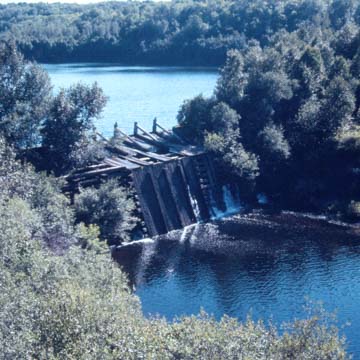When the Baltic Mining Company built a stamp mill on Lake Superior just west of the Salmon Trout River, a log dam constructed across the river by the Atlantic Mining Company in 1894 proved inadequate. So the two mining companies built jointly a new dam and shared the larger water supply. Because there was no suitable building stone available in the vicinity, they constructed a steel gravity dam. This structure was only the second dam of that design in the United States and the first of significant size. Crews began construction on the new Redridge Dam in May 1900 and completed it in November 1901. The designer was J. F. Jackson, engineer for the Wisconsin Bridge and Iron Company, with F. Foster Cromwell, a hydraulic engineer from New York, serving as the consulting engineer. Overall, the Redridge Dam is 1,006 feet long, consisting of a center steel-and-concrete section 464 feet long and two earth embankment wings with concrete core walls. This remarkable structure created a reservoir of 600 million gallons, ample storage for the two mills, which used an average of 25.5 million gallons daily. The Redridge Dam is one of only three steel dams erected in the United States between 1895 and 1910. It is the largest of the two surviving structures (the other is the Ashfork-Bainbridge Steel Dam, 1898, Ash Fork, Arizona) and exemplifies a type of dam construction briefly considered as an alternative to more traditional methods.
You are here
Redridge Dam
1900–1901, J. F. Jackson, engineer; F. Foster Cromwell, hydraulic engineer. Off S-554, less than 0.25 miles south of Redridge
If SAH Archipedia has been useful to you, please consider supporting it.
SAH Archipedia tells the story of the United States through its buildings, landscapes, and cities. This freely available resource empowers the public with authoritative knowledge that deepens their understanding and appreciation of the built environment. But the Society of Architectural Historians, which created SAH Archipedia with University of Virginia Press, needs your support to maintain the high-caliber research, writing, photography, cartography, editing, design, and programming that make SAH Archipedia a trusted online resource available to all who value the history of place, heritage tourism, and learning.















